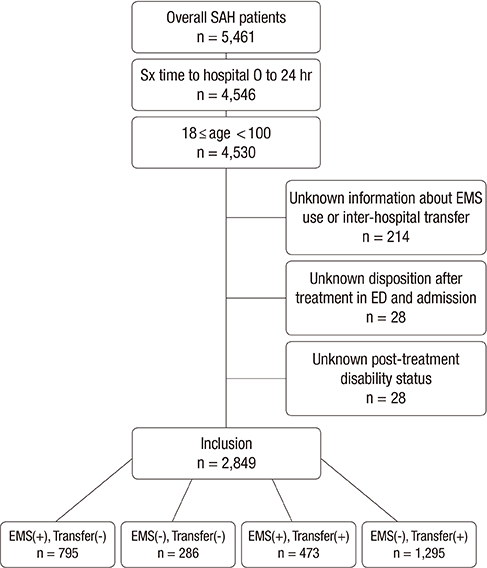J Korean Med Sci.
2015 Dec;30(12):1889-1895. 10.3346/jkms.2015.30.12.1889.
The Relationship between Clinical Outcome in Subarachnoidal Hemorrhage Patients with Emergency Medical Service Usage and Interhospital Transfer
- Affiliations
-
- 1Department of Emergency Medicine, Seoul National University College of Medicine and Hospital, Seoul, Korea. skciva@gmail.com
- 2Laboratory of Emergency Medical Services, Seoul National University Hospital Biomedical Research Institute, Seoul, Korea.
- 3Department of Emergency Medicine, UC Davis Medical Center(JFH), Davis, CA, USA.
- KMID: 2359976
- DOI: http://doi.org/10.3346/jkms.2015.30.12.1889
Abstract
- Prompt diagnosis and appropriate transport of patients with subarachnoid hemorrhage (SAH) is critical. We aimed to study differences in clinical outcomes by emergency medical services (EMS) usage and interhospital transfer in patients with SAH. We analyzed the CAVAS (CArdioVAscular disease Surveillance) database which is an emergency department-based, national cohort of cardiovascular disease in Korea. Eligible patients were adults with non-traumatic SAH diagnosed between January 2007 and December 2012. We excluded those whose EMS use and intershopital transfer data was unknown. The primary and secondary outcomes were mortality and neurologic status at discharge respectively. We compared the outcomes between each group using multivariable logistic regressions, adjusting for sex, age, underlying disease, visit time and social history. Of 5,461 patients with SAH, a total of 2,645 were enrolled. Among those, 258 used EMS and were transferred from another hospital, 686 used EMS only, 1,244 were transferred only, and 457 did not use EMS nor were transferred. In the regression analysis, mortality was higher in patients who used EMS and were transferred (OR 1.40, 95% CI 1.02-1.92), but neurologic disability was not meaningfully different by EMS usage and interhospital transfer. In Korea, SAH patients' mortality is higher in the case of EMS use or receiving interhospital transfer.
MeSH Terms
Figure
Reference
-
1. van Gijn J, Rinkel GJ. Subarachnoid haemorrhage: diagnosis, causes and management. Brain. 2001; 124:249–278.2. Adams HP Jr, Gordon DL. Nonaneurysmal subarachnoid hemorrhage. Ann Neurol. 1991; 29:461–462.3. Ingall T, Asplund K, Mähönen M, Bonita R. A multinational comparison of subarachnoid hemorrhage epidemiology in the WHO MONICA stroke study. Stroke. 2000; 31:1054–1061.4. Hop JW, Rinkel GJ, Algra A, van Gijn J. Case-fatality rates and functional outcome after subarachnoid hemorrhage: a systematic review. Stroke. 1997; 28:660–664.5. Mayer SA, Kreiter KT, Copeland D, Bernardini GL, Bates JE, Peery S, Claassen J, Du YE, Connolly ES Jr. Global and domain-specific cognitive impairment and outcome after subarachnoid hemorrhage. Neurology. 2002; 59:1750–1758.6. Hackett ML, Anderson CS. The Australian Cooperative Research on Subarachnoid Hemorrhage Study Group. Health outcomes 1 year after subarachnoid hemorrhage: An international population-based study. Neurology. 2000; 55:658–662.7. Berman MF, Solomon RA, Mayer SA, Johnston SC, Yung PP. Impact of hospital-related factors on outcome after treatment of cerebral aneurysms. Stroke. 2003; 34:2200–2207.8. Cross DT 3rd, Tirschwell DL, Clark MA, Tuden D, Derdeyn CP, Moran CJ, Dacey RG Jr. Mortality rates after subarachnoid hemorrhage: variations according to hospital case volume in 18 states. J Neurosurg. 2003; 99:810–817.9. Johnston SC. Effect of endovascular services and hospital volume on cerebral aneurysm treatment outcomes. Stroke. 2000; 31:111–117.10. Sakaki T, Morimoto T, Hoshida T, Kawaguchi S, Nakase H, Fukuzumi A. Rebleeding during transport of patients with a ruptured intracranial aneurysm. J Stroke Cerebrovasc Dis. 1999; 8:38–41.11. Inagawa T, Kamiya K, Ogasawara H, Yano T. Rebleeding of ruptured intracranial aneurysms in the acute stage. Surg Neurol. 1987; 28:93–99.12. Fujii Y, Takeuchi S, Sasaki O, Minakawa T, Koike T, Tanaka R. Ultra-early rebleeding in spontaneous subarachnoid hemorrhage. J Neurosurg. 1996; 84:35–42.13. Ohkuma H, Tsurutani H, Suzuki S. Incidence and significance of early aneurysmal rebleeding before neurosurgical or neurological management. Stroke. 2001; 32:1176–1180.14. Bardach NS, Olson SJ, Elkins JS, Smith WS, Lawton MT, Johnston SC. Regionalization of treatment for subarachnoid hemorrhage: a cost-utility analysis. Circulation. 2004; 109:2207–2212.15. Wilson TJ, Saadeh Y, Stetler WR Jr, Pandey AS, Gemmete JJ, Chaudhary N, Thompson BG, Fletcher JJ. Transfer time to a high-volume center for patients with subarachnoid hemorrhage does not affect outcomes. J Stroke Cerebrovasc Dis. 2015; 24:416–423.16. Duncan RP. Uncompensated hospital care. Med Care Rev. 1992; 49:265–330.17. Jencks SF, Bobula JD. Does receiving referral and transfer patients make hospitals expensive? Med Care. 1988; 26:948–958.18. Borlase BC, Baxter JK, Kenney PR, Forse RA, Benotti PN, Blackburn GL. Elective intrahospital admissions versus acute interhospital transfers to a surgical intensive care unit: cost and outcome prediction. J Trauma. 1991; 31:915–918.19. Gordon HS, Rosenthal GE. Impact of interhospital transfers on outcomes in an academic medical center. Implications for profiling hospital quality. Med Care. 1996; 34:295–309.20. Bellingan G, Olivier T, Batson S, Webb A. Comparison of a specialist retrieval team with current United Kingdom practice for the transport of critically ill patients. Intensive Care Med. 2000; 26:740–744.21. Westfall JM, Kiefe CI, Weissman NW, Goudie A, Centor RM, Williams OD, Allison JJ. Does interhospital transfer improve outcome of acute myocardial infarction? A propensity score analysis from the Cardiovascular Cooperative Project. BMC Cardiovasc Disord. 2008; 8:22.22. Tokuda Y, Inagawa T, Katoh Y, Kumano K, Ohbayashi N, Yoshioka H. Intracerebral hematoma in patients with ruptured cerebral aneurysms. Surg Neurol. 1995; 43:272–277.
- Full Text Links
- Actions
-
Cited
- CITED
-
- Close
- Share
- Similar articles
-
- Requests for Interhospital Transfer Received by An 1339 Emergency Medical Information Center
- Analysis of Factors Related to Delayed Answer in Interhospital Transfer Refer
- Changes in Interhospital Transfer Patterns of Acute Ischemic Stroke Patients in the Regional Stroke Care System After Designation of a Cerebrovascular-specified Center
- Impact of Interhospital Transfer in Mortality of Critically Ill Patients
- Criminal Responsibility in Emergency Care


